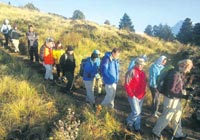

TAAN seeks new trekking destinations

Though figures for 2012 show an increase in the number of trekkers, trekking agents have claimed there still is a need to diversify trekking destinations.
“There has been a growth in number of trekkers but trekking in our country is still limited to only three regions,” said chief executive officer of Trekking Agencies’ Association of Nepal (TAAN) Gangaram Pant.
Trekking activities are limited to the Annapurna, Langtang and Everest regions. “The government and the private sector must work together to diversify trekking destinations,” he said.
In 2012, TAAN in coordination with the government started around 12 different trekking destinations but due to lack of proper infrastructure and quality promotion, trekkers have been concentrated in only Annapurna, Langtang and Everest regions. “We are also planning to develop new trekking routes to Humla starting from March this year,” he said.
According to TAAN, among various trekking destinations, around 80 per cent tourists are mainly attracted to Annapurna, Everest and Langtang regions and a few others also opt for Lower Dolpa, Ganesh Himal and some trek to restricted areas such as Manaslu, Manang and Chun Valley.
In 2012, TAAN issued more than 87,000 TIMS card for group trekkers while the number was 83,000 in 2011, and in 2010 it was around 68,000. In addition, the number of individual trekkers was around 1.5 lakh in 2012.
Meanwhile, the number of trekkers to the restricted regions was around 12,000. “The government allows a limited number of trekkers in the restricted regions, that is around 10,000, but figures show an increased number of trekkers attracted to the restricted regions for trekking,” said Pant.
The government has restricted Manaslu, Mustang and Chun Valley for trekking. However, it allows a limited number of trekkers and a guide is a must with additional entry charges.
“It is time we offered trekkers more options along with our traditional destinations, which will minimise the crowd at
the regular destinations and promote other destinations too,” said Pant.
According to him, it is difficult to trace the nationality of trekkers and destinations they are travelling to. “We do not have specific data of the places the trekkers will be travelling to but now we are planning to introduce a barcode system which will make it easier to record details and trace the trekkers and the destinations they are travelling to,” he said.
source: The Himalayan Times,11 Jan 2013








